Origin of Bengal Cats
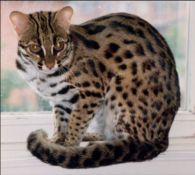 The Bengal breed originated by breeding an Asian Leopard Cat (felis bengalensis) to an
Egyptian Mau, Abyssinian, or other domestic shorthaired breed. There were a number of
goals for this type of breeding. One was to create a smaller version of the beautiful
wild cats of the jungle, while maintaining a dependable temperament of a family pet.
It was hoped that people's desire to own a wild animal would be satisfied by owning one
of these exotic-looking cats. In 1963, when Jean Mill bred the Asian Leopard with the
domestic cat, wild cats were being exploited for the fur market. So another goal of
this breeding was to deter people from purchasing the fur of wild cats by reminding them
of a family pet. It was hoped that the decrease in demand would result in less poaching
of wild cats. It appears that the trading of exotic cat fur has been restricted significantly
since. An additional goal for breeding Asian Leopards with domestic cats occured in the
1970's, when Jean Mill acquired 8 female Asian Leopard Cats (ALC) from the University of
California. These cats were used to study the ALC's natural immunity to Feline Leukemia.
The Bengal breed originated by breeding an Asian Leopard Cat (felis bengalensis) to an
Egyptian Mau, Abyssinian, or other domestic shorthaired breed. There were a number of
goals for this type of breeding. One was to create a smaller version of the beautiful
wild cats of the jungle, while maintaining a dependable temperament of a family pet.
It was hoped that people's desire to own a wild animal would be satisfied by owning one
of these exotic-looking cats. In 1963, when Jean Mill bred the Asian Leopard with the
domestic cat, wild cats were being exploited for the fur market. So another goal of
this breeding was to deter people from purchasing the fur of wild cats by reminding them
of a family pet. It was hoped that the decrease in demand would result in less poaching
of wild cats. It appears that the trading of exotic cat fur has been restricted significantly
since. An additional goal for breeding Asian Leopards with domestic cats occured in the
1970's, when Jean Mill acquired 8 female Asian Leopard Cats (ALC) from the University of
California. These cats were used to study the ALC's natural immunity to Feline Leukemia.
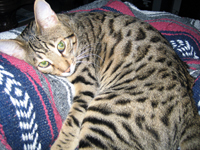
It was hoped that by breeding the ALC with a domestic cat, the offspring would share the same
immunity. Unfortunately, it was later discovered that Bengal cats do not possess the same
natural immunity to leukemia as do their Asian Leopard ancestors.
The breeding of the ALC and the domestic cat results in an F-1 kitten, the "one"
signifying that the kitten is one generation removed from the Asian Leopard Cat (ALC).
When the F-1 female Bengal (F-1 males are sterile) is bred to a domestic cat, the resulting
kitten is an F-2. The breeding of the F-2 results in F-3, and so forth. Only Bengal to
Bengal breedings that are at least four generations removed from the ALC are considered
"domesticated" and accepted in the show halls. These Bengals are referred to as
Stud Book Tradition (SBT).
Bengal Markings
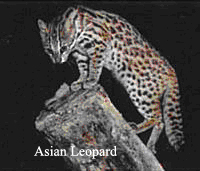 There are a number of different colors and markings on a Bengal. The traditional brown spotted
Bengal is the one that most closely resembles the ALC. These Bengals have brown or black spots
set on a golden, tan, or an orange variant shade body. The spots should flow horizontally,
and the greater the contrast between the spots and the ground color, the better.
There are a number of different colors and markings on a Bengal. The traditional brown spotted
Bengal is the one that most closely resembles the ALC. These Bengals have brown or black spots
set on a golden, tan, or an orange variant shade body. The spots should flow horizontally,
and the greater the contrast between the spots and the ground color, the better.
Marble Bengals
The marbled pattern is a combination of swirls and rosettes flowing in a horizontal fashion.
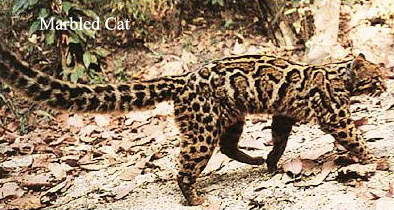 The pattern should be random, flow horizontally, and give the impression of marble. Though this
pattern was derived from the Classic tabby gene, they share a strong resemblance to the Clouded
Leopard and Marbled Cat. Again, these wild cats only share a resemblance in pattern with the
Marbled Bengal, and have in no way been used to breed Bengals.
The pattern should be random, flow horizontally, and give the impression of marble. Though this
pattern was derived from the Classic tabby gene, they share a strong resemblance to the Clouded
Leopard and Marbled Cat. Again, these wild cats only share a resemblance in pattern with the
Marbled Bengal, and have in no way been used to breed Bengals.
|
Snow Bengals
Snow Bengals are just like traditional spotted and marble Bengals, except for that their spots
or marble are on a white background. There are many variations of snows, including the seal
mink, seal lynx, and seal sepia. Snow Bengals are meant to resemble the snow leopard.
|
Silver Bengals
The Silver Bengal has only recently been accepted for Championship titles. Silver Bengals
have virtually white undercoat color with pewter to jet black markings. Silvers can also
be spotted or marbled. A top quality Silver Bengal shares a very strong resemblance to a
snow leopard. For more information about the breed standards, see the following presentation
by Specialty Judges, Jeff and Heather Roberts. This presentation is an excellent resource
for breeders and Bengal enthusiasts, and is a very thorough and clear description of the
appearance and traits that we are striving for in Bengals:
BGBreedSeminar
|
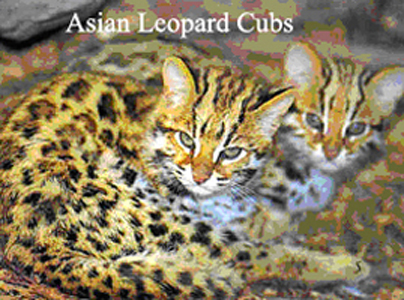
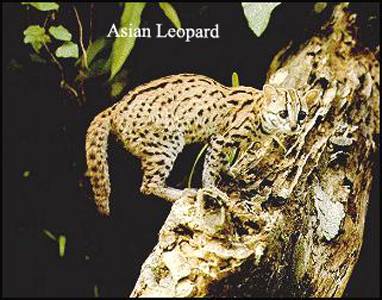
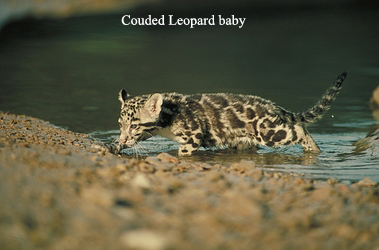
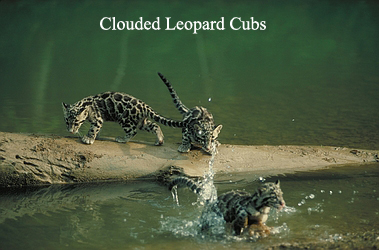
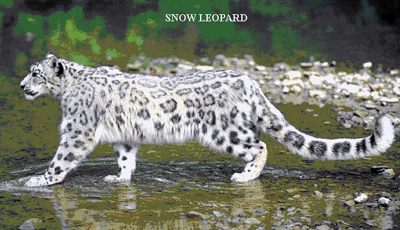
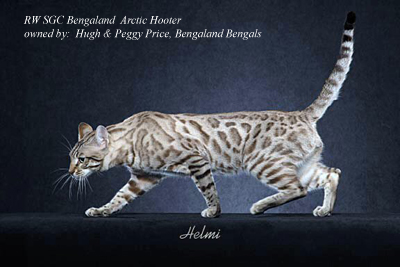
 The Bengal breed originated by breeding an Asian Leopard Cat (felis bengalensis) to an
Egyptian Mau, Abyssinian, or other domestic shorthaired breed. There were a number of
goals for this type of breeding. One was to create a smaller version of the beautiful
wild cats of the jungle, while maintaining a dependable temperament of a family pet.
It was hoped that people's desire to own a wild animal would be satisfied by owning one
of these exotic-looking cats. In 1963, when Jean Mill bred the Asian Leopard with the
domestic cat, wild cats were being exploited for the fur market. So another goal of
this breeding was to deter people from purchasing the fur of wild cats by reminding them
of a family pet. It was hoped that the decrease in demand would result in less poaching
of wild cats. It appears that the trading of exotic cat fur has been restricted significantly
since. An additional goal for breeding Asian Leopards with domestic cats occured in the
1970's, when Jean Mill acquired 8 female Asian Leopard Cats (ALC) from the University of
California. These cats were used to study the ALC's natural immunity to Feline Leukemia.
The Bengal breed originated by breeding an Asian Leopard Cat (felis bengalensis) to an
Egyptian Mau, Abyssinian, or other domestic shorthaired breed. There were a number of
goals for this type of breeding. One was to create a smaller version of the beautiful
wild cats of the jungle, while maintaining a dependable temperament of a family pet.
It was hoped that people's desire to own a wild animal would be satisfied by owning one
of these exotic-looking cats. In 1963, when Jean Mill bred the Asian Leopard with the
domestic cat, wild cats were being exploited for the fur market. So another goal of
this breeding was to deter people from purchasing the fur of wild cats by reminding them
of a family pet. It was hoped that the decrease in demand would result in less poaching
of wild cats. It appears that the trading of exotic cat fur has been restricted significantly
since. An additional goal for breeding Asian Leopards with domestic cats occured in the
1970's, when Jean Mill acquired 8 female Asian Leopard Cats (ALC) from the University of
California. These cats were used to study the ALC's natural immunity to Feline Leukemia.

 There are a number of different colors and markings on a Bengal. The traditional brown spotted
Bengal is the one that most closely resembles the ALC. These Bengals have brown or black spots
set on a golden, tan, or an orange variant shade body. The spots should flow horizontally,
and the greater the contrast between the spots and the ground color, the better.
There are a number of different colors and markings on a Bengal. The traditional brown spotted
Bengal is the one that most closely resembles the ALC. These Bengals have brown or black spots
set on a golden, tan, or an orange variant shade body. The spots should flow horizontally,
and the greater the contrast between the spots and the ground color, the better.
 The pattern should be random, flow horizontally, and give the impression of marble. Though this
pattern was derived from the Classic tabby gene, they share a strong resemblance to the Clouded
Leopard and Marbled Cat. Again, these wild cats only share a resemblance in pattern with the
Marbled Bengal, and have in no way been used to breed Bengals.
The pattern should be random, flow horizontally, and give the impression of marble. Though this
pattern was derived from the Classic tabby gene, they share a strong resemblance to the Clouded
Leopard and Marbled Cat. Again, these wild cats only share a resemblance in pattern with the
Marbled Bengal, and have in no way been used to breed Bengals.